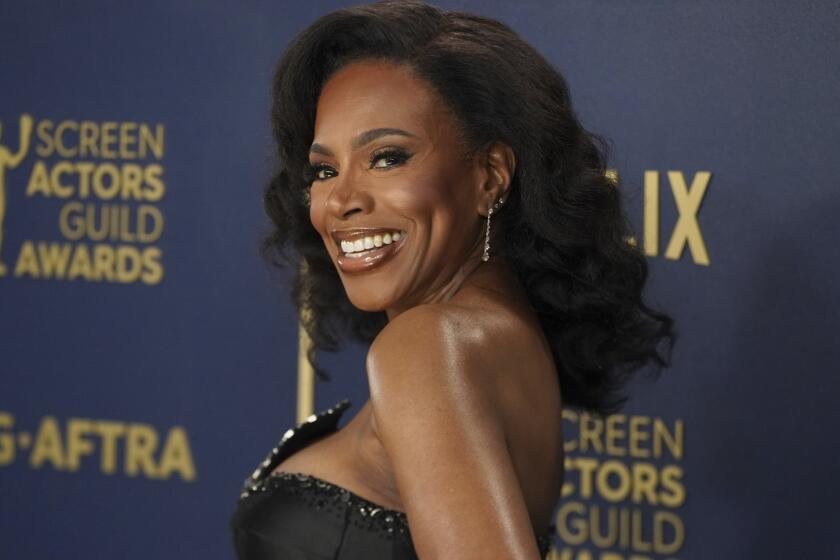The L words: lives, loves ... oh, and lesbians
Jennifer Beals steps gracefully out of a black stretch limo in tuxedo-like slacks and blouse, her long brown hair piled atop her head. It’s no surprise that the exotically beautiful actress has an attractive date on her arm -- except that her date happens to be a woman.
Beals and Laurel Holloman are shooting a scene for Showtime’s new series “The L Word.” They play a couple, Bette and Tina, in the first dramatic series to revolve around the lives and loves of lesbians.
Setting that precedent is enough of a burden for any show, but “The L Word” carries the weight of expectation too. The series is Showtime’s latest and perhaps best stab at grabbing some of the zeitgeist buzz and viewership of its larger archrival HBO.
Inside the cavernous warehouse-turned-soundstage on the rural outskirts of Vancouver, British Columbia, the crew shoots a scene set in a dance studio, where Pam Grier’s musician character is rehearsing a music video.
“One camera is supposed to be on Bette and Tina, I don’t know what happened here,” director Rose Troche yells across the soundstage from behind a monitor. Watching a woman take command of a set with mostly French-speaking crew members is not such a big deal, especially in Canada. But when the show’s creator, several producers, most of the writing staff and eight out of nine main characters are also women, it feels big.
After years on male-driven sets, working with women “who feel pretty good within their own skin,” is a refreshing change, says Beals, who plays a biracial lesbian and curator of a prestigious Los Angeles museum.
In the past, women have tried to “shove my characters into miniskirts and high heels, trying to imagine what the men would do,” says Beals, still best known for her star-making role in “Flashdance.” And although there are titillating scenes, “This group of women is very different. It was an amazing experience.”
Ironically, the criticism that creator-executive producer Ilene Chaiken is hearing is that the actresses are all “too pretty.”
A glance around the set and yes, most of the cast is young, thin and attractive. No buzz cuts or comfortable shoes in sight (although there aren’t many glamour scenes either).
But if the show contradicts lesbian stereotypes, it’s unintentional. Chaiken (“Dirty Pictures,” “Barb Wire”) says she is merely representing what she knows.
“I’ll never do anything that’s more personal to me,” says Chaiken, a small, intense woman who’s more akin to Restoration Hardware than Home Depot. But as a seasoned writer and producer in Hollywood, her goal is simply to put on a good show.
“It would be lovely if it had some positive effect, but I don’t feel any kind of social or political responsibility. My responsibility is to tell good stories.”
“The L Word” follows a group of lesbian professionals living in West Hollywood. The city’s blend of trendy cafes and small-town charm is splendidly recreated indoors on Vancouver soundstages, including the distinctive bungalow houses and even a backyard pool. Only some exterior vistas of notable landmarks were shot in Southern California.
Life in “The L Word’s” WeHo is rather ordinary -- apart from men in a diminished role and the women “linked because of friendship and romance,” Chaiken says.
But the show isn’t about only lesbians. Straight couple Tim and Jenny (Eric Mabius and Mia Kirshner) are central to the story line, and the relationship between half-sisters Bette and Kit (Grier) veers off into issues of race, alcoholism and sibling rivalry. (Their father is portrayed by Ossie Davis, in a poignant guest appearance.)
Sexuality “is part of who we are, but it’s not all of who we are,” says Erin Daniels (“One Hour Photo”), who plays a closeted tennis pro. “I think the show establishes that. But these characters are lesbian, you can’t ignore that either -- and you don’t want to because it’s interesting.”
Her fit physique makes Daniels a believable professional athlete. She, Leisha Hailey and Katherine Moennig hang together as single friends looking for love on the show and are nearly inseparable off camera as well. They laugh and chatter in one corner while Beals, Holloman and Grier shoot scenes in another part of the warehouse. (Karina Lombard, who plays cafe owner Marina, has the day off.) Free time is typically spent exploring the trails and trendy restaurants of scenic Vancouver, or everyone gathers for dinner at one person’s house.
During a lunch break Holloman talks about how she identifies with the maternal, feminine Tina, a sharp contrast to the butch lesbian she played in “The Incredibly True Adventures of Two Girls in Love” (1995).
“I think a lot of issues women have in their 30s about having children and wanting to still have a career come up with my character Tina,” says the soft-spoken actress, with shoulder-length blond hair and dressed in a sari. “When she decides to walk away from her career and have a child, she loses a lot of identity and becomes incredibly co-dependent on Jennifer’s character.”
“The L Word” enters the scene at a time when TV is teeming with gays and gay imagery. The flurry includes sitcoms such as NBC’s Thursday night staple “Will & Grace” to dramas such as Showtime’s own “Queer as Folk” and HBO’s “Six Feet Under” and unscripted shows such as Bravo’s “Queer Eye for the Straight Guy.” Ellen DeGeneres has a hit daytime talk show as well.
What’s different about “The L Word” is that none of these shows focused specifically on lesbians. Sexuality aside, Showtime is hoping its new series can carve out a particular niche as a show that targets women.
“With ‘Sex and the City’ going off into the sunset I can’t think of another strong female-ensemble show on the air,” says Robert Greenblatt, Showtime’s president of entertainment. “I hope that’s as much of a draw as the lifestyle.”
“The L Word” “isn’t nearly as incendiary and deals less frankly with sex” than “Queer as Folk,” Greenblatt says. And unlike “Queer as Folk,” the show had little trouble attracting familiar actors.
Hailey is the cast’s only openly gay member, and the rest of the actors are more concerned about being truthful than about their characters’ sexuality.
“It was much easier to do a love scene with another woman,” Beals says earlier by phone. “With a man you say, ‘Can you put your hand here because [I feel] a little fat?’ They may not really understand how important it is that they keep their hand there.”
“There’s nothing that I have to explain to anyone,” jokes the effervescent Hailey, who brings much gaiety -- in the most conventional sense of the word -- to the role of the bisexual journalist. She, perhaps more than anyone, feels a certain responsibility on the show.
“The gay and lesbian community is so hungry to be represented,” says the actress, who studied drama before co-founding the band the Murmurs. Seated in a quiet upstairs office at the studio, she says the pressure comes in “representing every lesbian. That’s almost impossible when you have one show, but I think that it’s still just as important -- no matter how far we get with the show -- that it’s happening in the first place.”
“The L Word” has been called everything from the female “Queer as Folk” to the lesbian “Sex and the City.” Mabius, the lone male lead, likes Beals’ description: “ ‘Sex and the City’ if it was an hourlong drama and some of the women had slept together.”
“The L Word” could be “a revelation” to viewers who have expectations derived from stereotypes, says Chaiken, who’s been in a relationship for 20 years and has 8-year-old twins.
“People who come to see something that’s a little thrilling and different to them will definitely get what they’re coming for. But I think the larger experience will be people finding common ground and, in some cases, realizing for the first time that we’re all going through the same things.”
The complete guide to home viewing
Get Screen Gab for everything about the TV shows and streaming movies everyone’s talking about.
You may occasionally receive promotional content from the Los Angeles Times.



